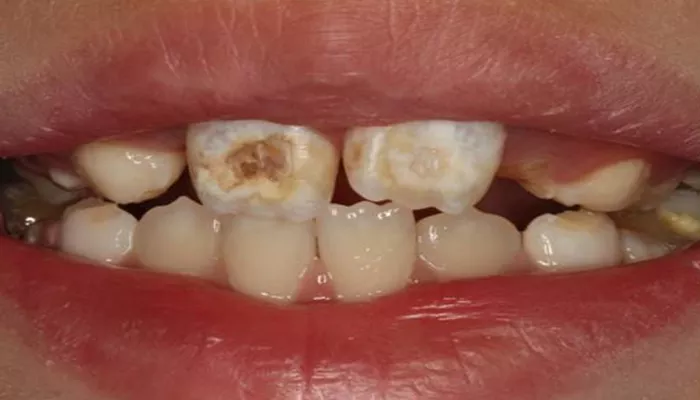Tooth decay, or dental caries, is a prevalent oral health issue that affects millions of people worldwide. It occurs when acids produced by bacteria in dental plaque attack the tooth enamel, leading to gradual destruction of the tooth structure. This process can lead to various complications if left untreated, posing significant risks to overall health. In this article, we will explore the potential dangers of tooth decay from a dental professional’s perspective, shedding light on its impact on oral health, general well-being, and quality of life.
Understanding Tooth Decay: The Basics
Tooth decay begins with the formation of dental plaque, a sticky film of bacteria that constantly forms on teeth and gums.
These bacteria feed on sugars and starches from food and drinks, producing acids as a byproduct. Over time, these acids can erode tooth enamel, the hardest substance in the human body, creating tiny holes or cavities known as caries. If not addressed promptly, these cavities can grow larger, affecting deeper layers of the tooth, including the dentin and pulp.
The Immediate Consequences of Tooth Decay
Pain and Discomfort
One of the most immediate consequences of tooth decay is pain. As the decay progresses, it can irritate the nerve endings within the tooth, leading to sensitivity to hot and cold foods, spontaneous pain, and even throbbing or aching sensations.
This discomfort can interfere with daily activities, such as eating, sleeping, and concentrating.
Infection and Inflammation
If tooth decay reaches the pulp of the tooth, it can cause an infection. This infection can spread to surrounding tissues, leading to swelling, redness, and inflammation. In severe cases, it may even necessitate emergency dental treatment to prevent life-threatening complications.
Tooth Loss
Advanced tooth decay can weaken the tooth structure to the point of fracture or complete loss. Tooth loss can have a profound impact on chewing function, facial aesthetics, and self-esteem. It can also lead to shifts in adjacent teeth, bite alignment issues, and temporomandibular joint (TMJ) disorders.
The Long-Term Health Risks of Tooth Decay
Systemic Infections
Tooth decay is not just a localized oral issue. In some cases, infections can spread beyond the oral cavity to other parts of the body, causing systemic infections. These infections can affect vital organs, such as the heart, lungs, and kidneys, and may exacerbate existing medical conditions like diabetes and heart disease.
Nutritional Deficiencies
Tooth decay can make chewing difficult and painful, leading to a restricted diet. This restriction can cause nutritional deficiencies, as individuals may avoid eating certain foods, particularly those that are hard, crunchy, or acidic. Over time, these deficiencies can compromise immune function, slow wound healing, and increase the risk of chronic diseases.
Poor Quality of Life
The pain, discomfort, and aesthetic issues associated with tooth decay can significantly impact quality of life. It can affect social interactions, job performance, and overall mood. People with severe tooth decay may feel embarrassed about their smile, leading to social isolation and depression.
Increased Healthcare Costs
Treating tooth decay can be costly. From fillings and crowns to root canals and extractions, the expenses can add up quickly.
In severe cases, tooth loss may necessitate more extensive and expensive treatments, such as dental implants or bridges.
Preventive dental care, such as regular check-ups, cleanings, and fluoride treatments, is a more cost-effective approach to managing tooth decay.
The Role of Preventive Dental Care
Given the significant health risks associated with tooth decay, preventive dental care is crucial. Here are some key steps that individuals can take to reduce their risk of tooth decay:
Brush and Floss Daily
Brushing teeth at least twice a day with fluoride toothpaste and flossing daily can help remove plaque and food particles from the teeth and gums. This reduces the amount of bacteria that can produce acids and cause decay.
Healthy Diet
Limiting sugary snacks and drinks can help reduce the amount of acid produced by bacteria in the mouth. Eating a balanced diet rich in fruits, vegetables, lean proteins, and whole grains can provide essential nutrients for oral and overall health.
Regular Dental Check-Ups
Visiting the dentist for regular check-ups and cleanings can help detect and treat tooth decay in its early stages. Professional cleanings can remove hardened plaque (tartar) that cannot be removed with brushing and flossing.
Fluoride Treatments
Fluoride is a natural mineral that strengthens tooth enamel, making it more resistant to acid attack. Fluoride treatments, such as varnishes, gels, or rinses, can be applied by dental professionals or used as part of a daily oral hygiene routine.
Sealants and Restorations
Dental sealants can be applied to the chewing surfaces of molars to prevent decay in these hard-to-clean areas.
Restorations, such as fillings and crowns, can repair damaged teeth and prevent further decay.
Conclusion
In conclusion, tooth decay is not just a cosmetic issue; it poses significant risks to overall health. From pain and discomfort to systemic infections and nutritional deficiencies, the consequences of tooth decay can be severe. Preventive dental care, including daily brushing and flossing, a healthy diet, regular check-ups, fluoride treatments, and restorative treatments, is essential for maintaining oral health and preventing the long-term consequences of tooth decay. By taking proactive steps to care for their teeth and gums, individuals can enjoy better oral health, improved quality of life, and reduced healthcare costs.
Related topics:

